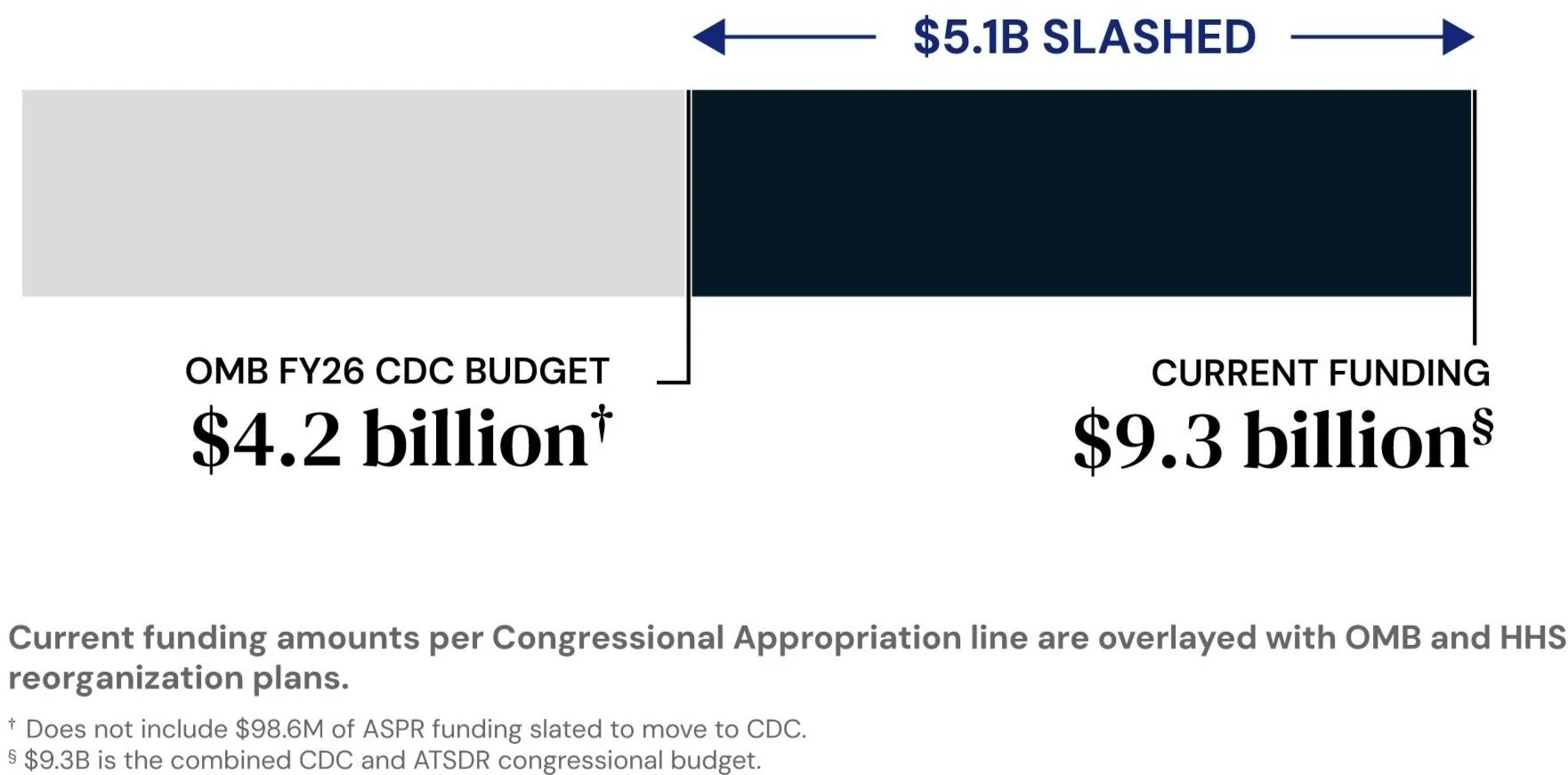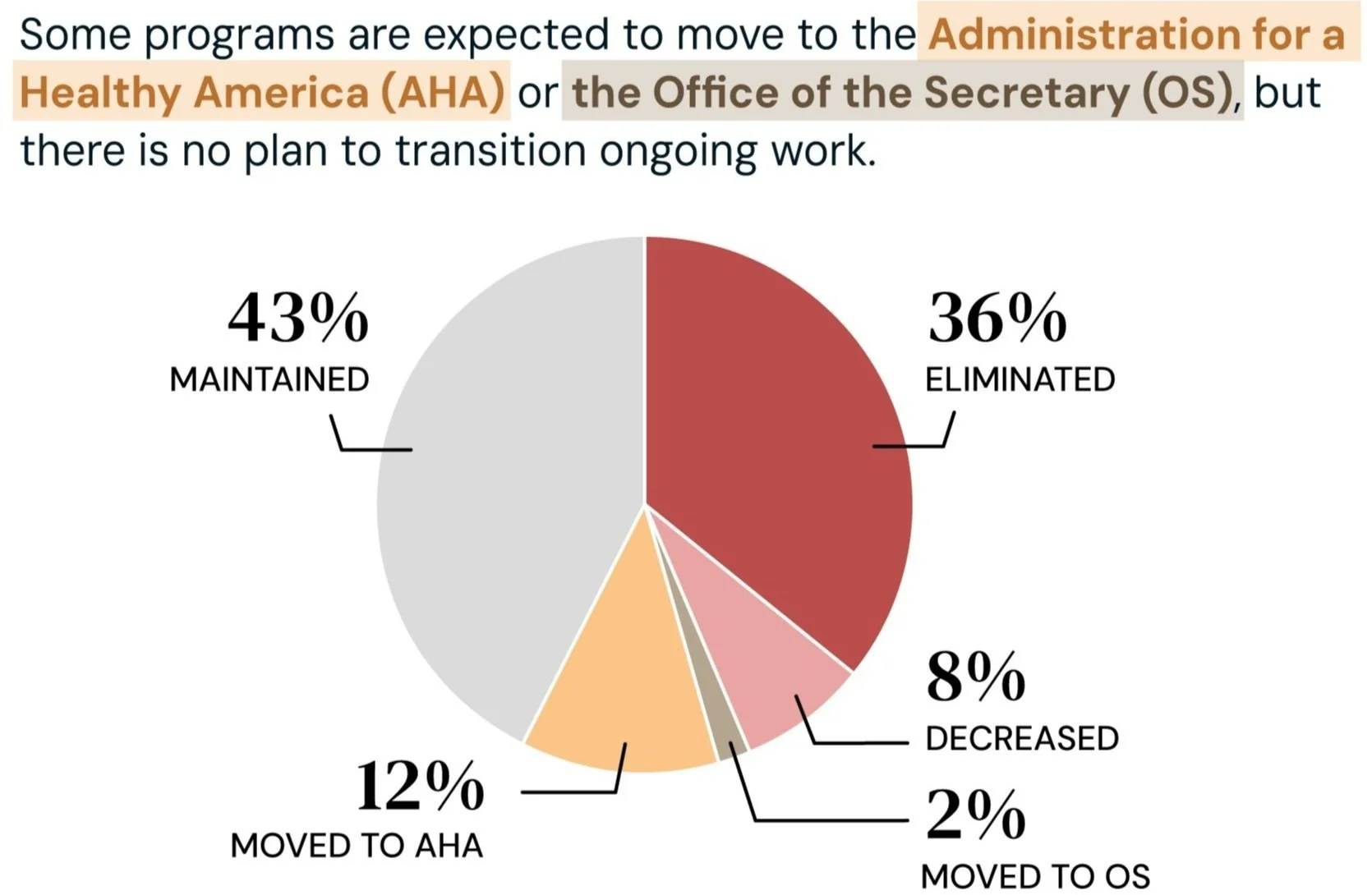In the proposed FY26 budget, programs that help Americans live safer, healthier, longer lives are on the chopping block. Reductions in force (RIFs) at the CDC further threaten these programs and America’s ability to respond to emergencies.
OMB and the White House suggest slashing CDC’s budget by more than half (54%).
Most programs will not be moved to AHA.
Status of CDC programs in the FY26 budget.
How will current Center-level funding be impacted?
Take a closer look at this chart by visiting the budget page from your desktop device.
Lost grants hurt states and local communities.
The CDC has lost one-third of its civil service workforce since January 2024, with many CDC branches (units) facing complete elimination.
-
AHA = Administration for a Healthy America; OS = HHS Office of the Secretary; ATSDR = Agency for Toxic Substances and Disease Registry; EEOICPA = Energy Employees Occupational Illness Compensation Program
§ $9.3B is the combined CDC and ATSDR budget
* Chronic Disease Prevention and Health Promotion program funding has been eliminated; however, the Alzheimer’s Program was maintained and moved to AHA with a $35M budget
** 1.0B Domestic HIV Prevention funding has been eliminated; however, $300M is proposed in the new FY budget proposal under a new consolidated grant encompassing hepatitis, STD, and TB. Most of Domestic HIV has been eliminated; however, the Ending the HIV Epidemic moves to AHA with a $220M budget
*** Eliminates the Global Health Center, including global immunization programs and Global HIV/TB. Maintains $293M for Global Health Protection for disease detection that will be moved under CDC-Wide Activities and Program Support budget, as well as $29M for malaria that is slated to move to the National Center for Emerging and Zoonotic Infectious Diseases. Unclear what will happen to the PEPFAR program.
A Historic Threat to America’s Health Security
The proposed budget represents an unprecedented assault on America's health security, slashing up to 54% of the funding deemed essential by Congress for CDC programs.
The graphics above clearly displays the Centers for Disease Control and Prevention (CDC) current program funding overlaid with the Office of Management and Budget (OMB) and Health and Human Services (HHS) plans to move programs to the Administration for HealthyAmerica (AHA), the HHS Office of the Secretary (OS), or eliminate entire programs, including the entire National Center for Chronic Disease and Health Promotion.
Programs Eliminated Despite Claimed Priorities
Programs that track and combat America's leading killers (obesity, cancer, diabetes, heart disease, smoking) face elimination despite Make America Healthy Again (MAHA) stated health priorities.
The very programs that the MAHA initiative and Secretary Kennedy claim to champion are slated for elimination.
Gutting CDC Investments in States and Local Communities Will Destroy Local Public Health.
The CDC invests 80% of its annual domestic budget in states, tribes, and communities—not D.C. bureaucrats. Eliminating this support will impact every person in the country. In 2023 alone, $4.7 billion in grants supported health departments, hospitals, universities, and nonprofits across the country.
Cuts to these investments harm states and local communities far more than CDC workers. On average, nearly 50% of every state’s public health budget comes from HHS. In many states, nearly all federal funds are from CDC. Now, over half of that support that directly invests in states’ programs, salaries, training, data collection and use, and innovation is at risk, and state and local health departments are forced to consider scaling back public health functions, staffing, and programs they know will weaken their ability to keep their residents healthy and safe, identify and prevent diseases, and respond to emergencies.
Lack of Planning, Destruction of Essential Services
Very few existing programs are transitioning to the new AHA agency. Despite claims by OMB, CDC leadership, many of whom were laid off in April, was not engaged in reorganization or transition planning.
No transition plan exists for dedicated staff or their decades of life-saving work.
These aren't inefficiencies being trimmed or duplicative programs; these are proven, essential programs being destroyed wholesale.
This isn't about efficiency
Dismantling essential systems and starting from scratch wastes resources, destroys institutional knowledge, and creates dangerous gaps in protection.
The most efficient approach would be strengthening existing programs that already work, not obliterating them to build costly, untested replacements.
Undermining a Century of Public Health Progress
Critically important public health investments are being unnecessarily and wastefully ignored, upending more than a century of shared values & understanding of public health as a bipartisan public good. The United States has built the world's gold standard in public health innovation, earning global leadership through HHS programs that are both effective and cost-efficient. Our international reputation as pioneers in life-saving health programs – painstakingly built over generations – now faces obliteration.
Why Prevention Matters
Prevention is the CDC’s strength.
By preventing and reducing chronic diseases, the CDC saves lives, cuts healthcare costs, and sustains a healthy economy.
The Real Cost of Public Health Cuts
Public health cuts now mean higher healthcare costs later. In the U.S., diseases like heart disease, cancer, and diabetes combined account for over $1.3 trillion annually in healthcare spending and lost productivity. But CDC prevention programs have proven extraordinary returns; for example, the Million Hearts® initiative prevented an estimated 135,000 heart attacks, strokes, and other cardiovascular conditions/cardiac events from 2012 to 2016, averting $5.6 billion in medical costs.
We also know that investing in prevention upfront saves us money in the long term. We save $60 for every $1 spent on flu vaccines for seniors, and yet OMB’s proposed cuts target CDC’s wide range of prevention programs. Their cuts guarantee more outbreaks, ER visits, and higher health costs for taxpayers down the road. American taxpayers will ultimately pay the highest cost.
Take Action Now
Contact your representatives now.
Demand they stop this reckless gutting of public health programs and hold Kennedy accountable. The future of American public health hangs in the balance.
About This Project
This independent, non-governmental report and accompanying materials summarize entirely publicly available federal agency and budget data. It was developed independently of any federal agency. This project is a work in progress and will be updated as new budget information becomes available.
Abbreviations
AHA: Administration for a Healthy America
HHS: Health and Human Services
MAHA: Make America Healthy Again
OMB: Office of Management and Budget





